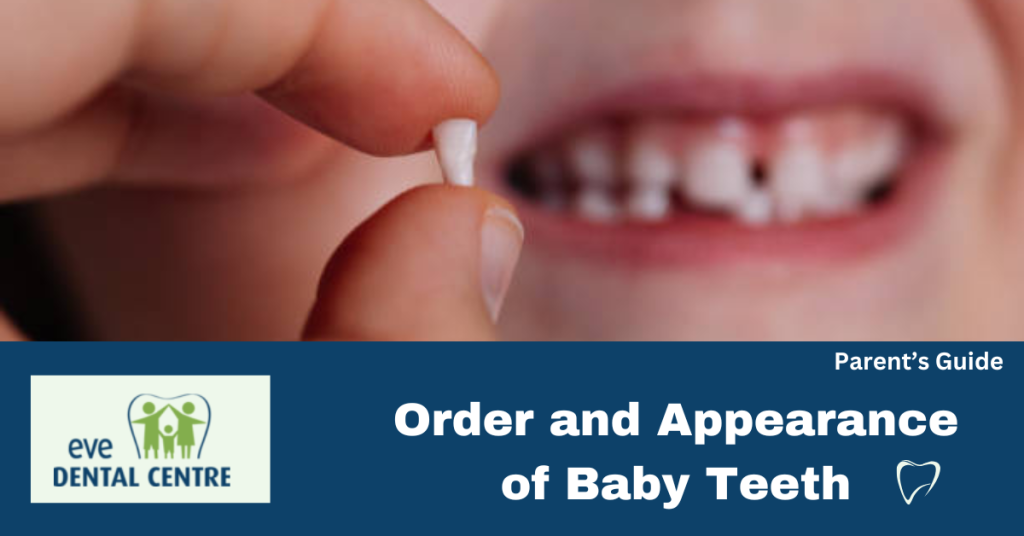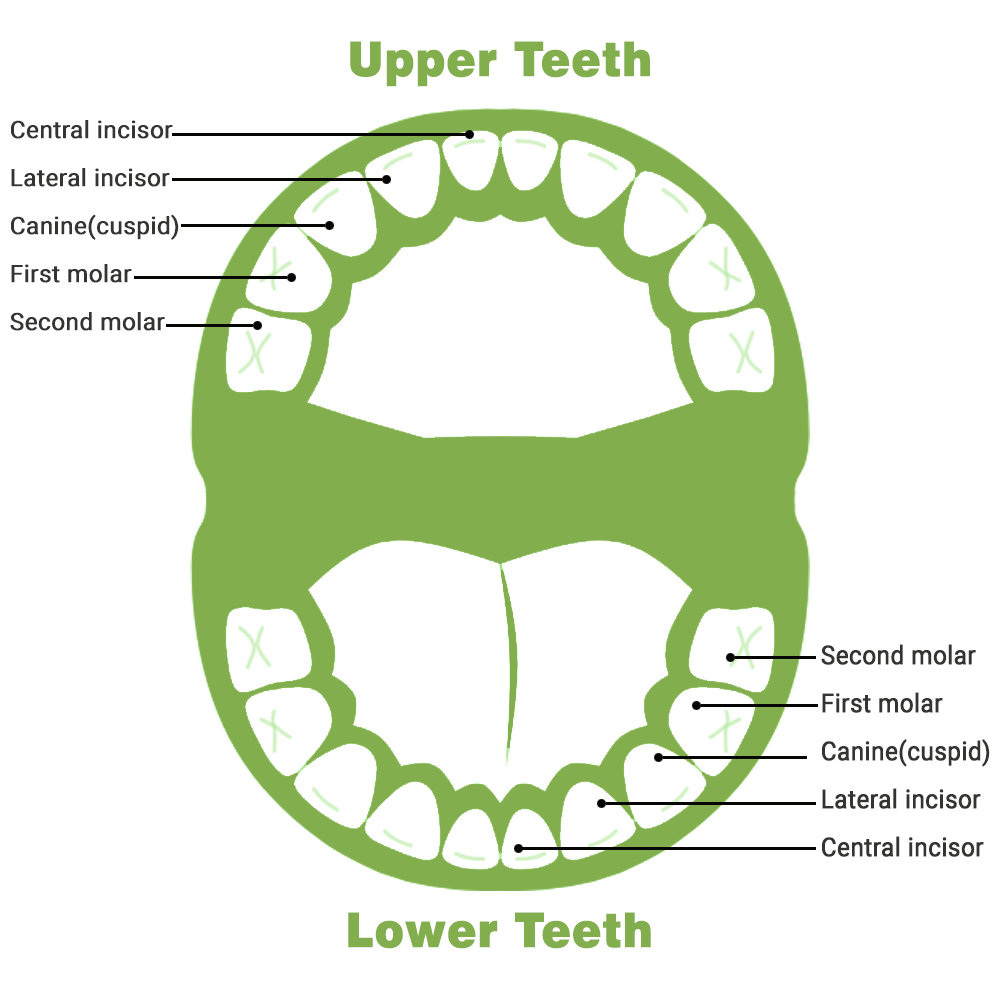The Complete Guide to the Order and Eruption of Baby Teeth: What Every Parent Needs to Know
Any parent can give their baby’s development a nod, as it is one of the most fascinating experiences one can ever go through. An important event is when the first baby teeth start to appear; it may be a fun process of teething, which is sometimes not easy. Knowing the baby teeth order is vital, as it helps you ensure that the baby’s teeth before the eruption and teething period are well managed. This definitive guide will cover everything from understanding the sequence of the first baby teeth to normal time frames and signs that may signal teething, as well as ways to soothe them.
What Are Baby Teeth?
Primary dentition, baby teeth, deciduous teeth, and milk teeth are the teeth that develop in the first place in children. A complete set in place at any one time is normally 20, although these give way to 32 permanent adult teeth after some time. The teeth development in a baby is meant to assist the child in many ways not limited to just chewing food.

The Importance of Baby Teeth
Although baby teeth are temporary, they serve several critical functions:
- Facilitating Eating: Baby teeth are important in biting and chewing food. They help in food intake and digestion. The babies feel comfortable shifting from liquid to solid foods easily.
- Supporting Speech Development: Baby teeth development leads to a clear voice. They maintain space for adult teeth and contribute to clear oration.
- Guiding Permanent Teeth: The temporary teeth have an important function in guiding the eruption of permanent teeth and also in the spacing of the dental arch.
- Contributing to Self-Esteem: Healthy teeth and strong gums do wonders for a child’s confidence. Another reason for the selection of healthy baby teeth is to enable the child to develop positive self-esteem.
What Is A Baby Teeth Chart?
A baby teeth chart is a useful guide that parents need to familiarize themselves with when developing their child’s dental plan. It is normal for many parents to ask when baby teeth come in, the order of baby teeth, and how their schedule looks. Most infants start developing their first teeth at around six months of age, although this may vary from child to child.
The most asked question is “Which baby teeth come first?” The baby teeth chart order typically indicates that the first two teeth to emerge are the lower central incisors, followed by the upper central incisors. Understanding this sequence can help parents prepare for what stage of teething their child is in and how best to care for them during this time.
Identifying the baby teeth growth order can help alleviate parental concerns regarding teething pain and developmental milestones. Following the central incisors, the next teeth to appear are the lateral incisors, then the first molars, canines, and finally the second molars, resulting in a total of 20 primary teeth by age three.

This chart not only aids in tracking dental development but also emphasizes the need for proper care of baby teeth, as they play a crucial role in guiding the position of permanent teeth. By studying the insights provided in the baby teeth chart, parents can better understand babies teeth order and promote their child’s dental health more effectively.
When Will Baby Teeth Grow?
Timing for when baby teeth appear should not be a cause of worry so that parents can be well prepared for teething phases. When do teeth come through? Ordinarily, the first teeth start to appear at six months but this may occur at any age past infancy. Below is a detailed timeline outlining the typical baby teeth order of eruption:
Children’s Baby Teeth Eruption Order & Timeline
| Tooth Type | Eruption Age | Description |
|---|---|---|
| Lower Central Incisors | 6-10 months | First to appear, located in the lower jaw. These teeth are essential for chunking and holding food firm. |
| Upper Central Incisors | 8-12 months | These follow the lower central incisors and are located in the upper jaw. |
| Upper Lateral Incisors | 9-13 months | Located near the upper central incisors, important for cutting food. |
| Lower Lateral Incisors | 10-16 months | Found below the upper lateral incisors, they assist with biting food. |
| First Molars | Lower First Molars: 14-18 months Upper First Molars: 13-19 months |
Larger teeth used for chewing and grinding food, located at the back of the mouth. |
| Canines (Cuspids) | Lower Canines: 17-23 months Upper Canines: 16-22 months |
Pointed teeth used for tearing food like flesh and muscles. |
| Second Molars | Lower Second Molars: 23-31 months Upper Second Molars: 25-33 months |
Last teeth to develop, important for grinding and chewing food. |
Our answer to when do baby teeth come- at the age of three most of the children would have been able to develop their 20 baby teeth. You can observe the above baby teeth growth order for a safer development.
Recognizing Teething Symptoms
It is quite a common occurrence that causes some distress to the baby and an equal measure of worry to the parent. It is important to know when your baby is teething to provide the right consoling process. Common symptoms include:
- Irritability and Fussiness: When the teeth start to grow, infants become more cranky than usual, which may upset the parent as well as the child.
- Increased Drooling: Children who are in this period are likely to put on more saliva, thereby drooling, which is normal. This is a normal reaction to an inflammation that is known to affect gums.
- Chewing on Objects: Again, babies even at this age find comfort in biting objects such as toys, fingers or any foreign object they find within their reach. It relieves the pressure from the erupting teeth as this behavior is shown to do.
- Swollen and Tender Gums: In particular, the gums adjacent to the area where a tooth is soon to emerge can become red, inflamed, and tender to the touch.
- Sleep Disturbances: Unluckily, teething can interfere with sleep so the child might wake up more frequently during the night.
When to Seek Medical Advice
Teething is mostly mild, but some signs require medical attention from your child’s pediatrician. If you’re wondering “What order do baby teeth come in”, it’s important to be aware of normal teething patterns.
In the event, that your child develops a fever that is slightly above one hundred and one degrees Fahrenheit, ongoing diarrhea, or rashes, seek pediatric dentistry services, as these could indicate a different issue with your child, especially if they occur before the eruption of baby teeth.
Also, when you see baby teeth coming in out of order, you require medical advice from a dentist.
Solutions for Relief of Teething Distress
As a parent, you can implement several strategies to help soothe your baby’s discomfort during the teething process:
- Teething Rings: Teething rings may be sucked but should not be frozen. The coolness has a sympathetic effect and does help eliminate some of the pain in the gums.
- Cold Washcloths: You can also take a clean wet washcloth, put it in the fridge until cold, and then let your baby take it in his mouth. The cold also has an advantage because the teeth can remarkably heal sore gums.
- Gentle Gum Massage: With a new clean finger, you can massage the gum of your baby. This may go a long way in easing the pressure and of course, offer a moment of relief.
- Pain Relief Medication: If your baby appears particularly uncomfortable, check with your pediatrician on the right doses of painkillers such as Paracetamol or Temesa.
- Distraction: Play or pulling your baby’s attention towards something new such as toys can help distract them and control the discomfort.
Caring for Baby Teeth
Even though the baby teeth are anyway going to fall out, they should still be brushed appropriately for the sake of maintaining great oral hygiene. Here are some essential tips for maintaining your child’s dental hygiene:
- Start Early: Even before teeth come out, start wiping your baby’s gums using a soft cloth or a special soft finger brush. It also assists in creating a habit and preparing your baby for oral care.
- Brushing: When teeth grow out, one should use tender bristles, a mound of paste of fluoride content, and clean your child’s teeth twice a day. This practice is essential if one is to avoid cavity formations in their teeth.
- Regular Dental Check-ups: Start your child’s dental appointments as early as possible, when they are 12 months or when they erupt their first teeth. Dental check-ups help the dentist to observe your child’s teeth development process as well as detect any developing problem.
- Limit Sugary Foods and Drinks: Avoid offering your child so much candy, chocolate, sweets, biscuits, pop, soft drinks etc. Like all sweets, sugars are bad for teeth, so even with baby teeth, it is crucial to encourage a balanced diet.
- Encourage Healthy Habits: Make it a point to tell your child to always drink water after each meal and should not breastfeed or have a bottle for longer than 20 minutes each time, especially at night. In this way, it removes the food particles on the teeth and leaves them with fewer chances of developing cavities.
Final Thoughts on Order and Appearance of Baby Teeth
Anything that helps you with baby teeth order and the time at which they are likely to occur can provide immense assistance in helping out this vital stage of a child’s development. Therefore, you need to understand teething symptoms to be able to offer the necessary comfort to your child engaged in the process of teething.
Practising correct dental care at an early age will create the right base for the child’s subsequent oral health. Welcome to this great phase of development and understand that with the right information at your fingertips, you can make the experience a comfortable one for your baby. Remember this phase shall come to pass one day leaving you with a healthy confident smile in your kid’s future.




